
Activated or oxidized charcoal is carbon that has been treated with either a combination of heat and pressure, or with a strong acid or base followed by carbonization, to make it highly porous and give it a very large functional surface area. This means its molecular structure is a bit like chicken wire, and it is filled with loads of ‘sticky’ holes that catch any toxins that pass through. This material was collected as part of our Gases open day where it formed part of a display exploring effervescent materials in their many forms.
This particular form of activated charcoal is Binchotan, a kind of hardwood charcoal that has been cultivated and used in Japan since the Edo period (17thCentury). It is traditionally made by charcoal makers in the Kishu province of Wakayama from Japanese Holm Oak or Ubamegashi wood,which grows on the forested hills of the Kii peninsula. It is made by stacking oak branches inside kilns and baking them at ultra-high temperatures for several weeks until they carbonize. The artisan controls the supply of oxygen, first shutting it off to carbonise the wood, and then increasing it to burn the wood at a very high temperature to activate it. This process, first developed over 300 hundred years ago, turns the wood into a charcoal with a particularly high carbon content (up to 98%). This results in a fire that burns at a constant heat, without smoke, at extremely high temperatures and that lasts for up to five hours. For this reason it is prized by chefs around the world because it is completely odourless, allowing the natural flavours of the food to come out, and it sears meat and fish quickly without the characteristic external burning of many less dense forms of charcoal. It is also used for water purification, dehumidifiers in rooms and as a soil improver.
Confusingly this type of charcoal is also called white charcoal, not because of the colour of the charcoal itself, which is a velvety deep black, but because of the white ash residue it leaves behind. To recognize this type of charcoal, you can tap two sticks of it together: you should hear a light metallic sound due to its high carbon content.
Sample ID: 1328
Particularities
- State
- Solid
- Compound
- Selections
- Healthy Materials
- Curiosities
- Transformative
- Relationships
- Absorbent | Adsorption | Black | Carbon | Charcoal | Filtration | Poison
Add materials you find interesting to your own selections.
Use the  button to select a material and get started.
button to select a material and get started.

